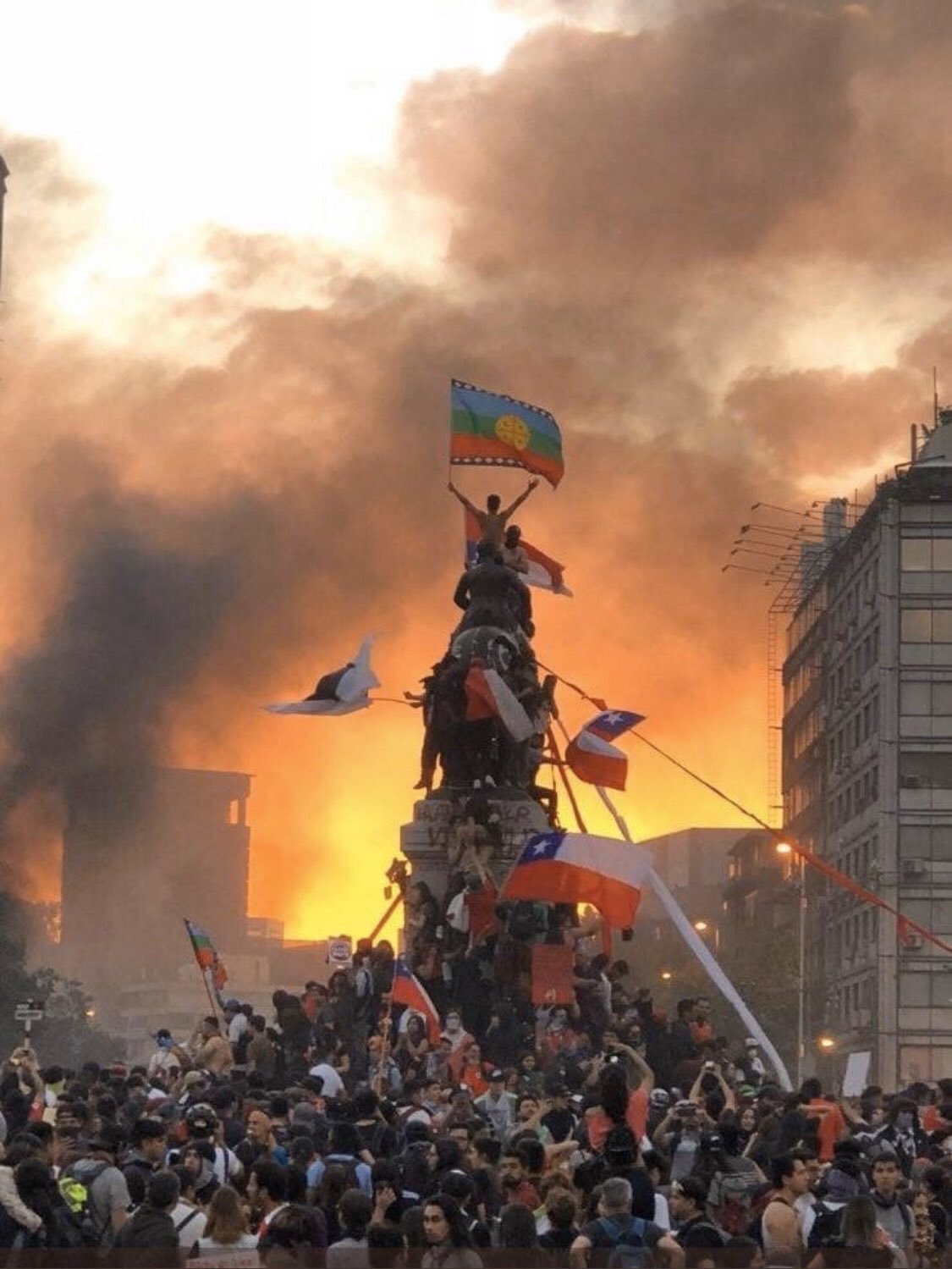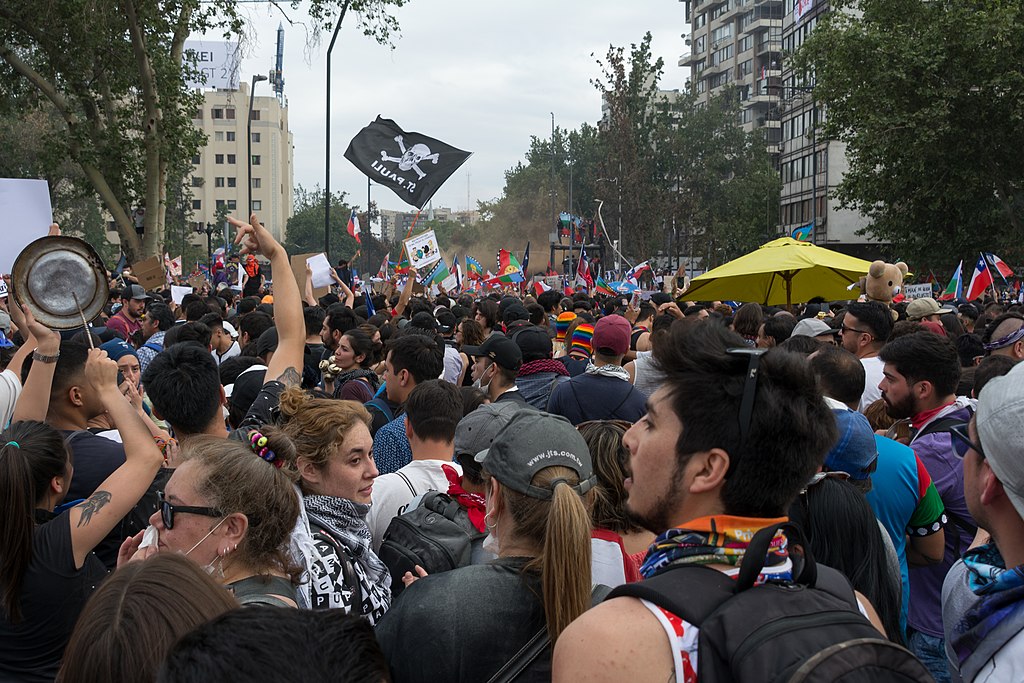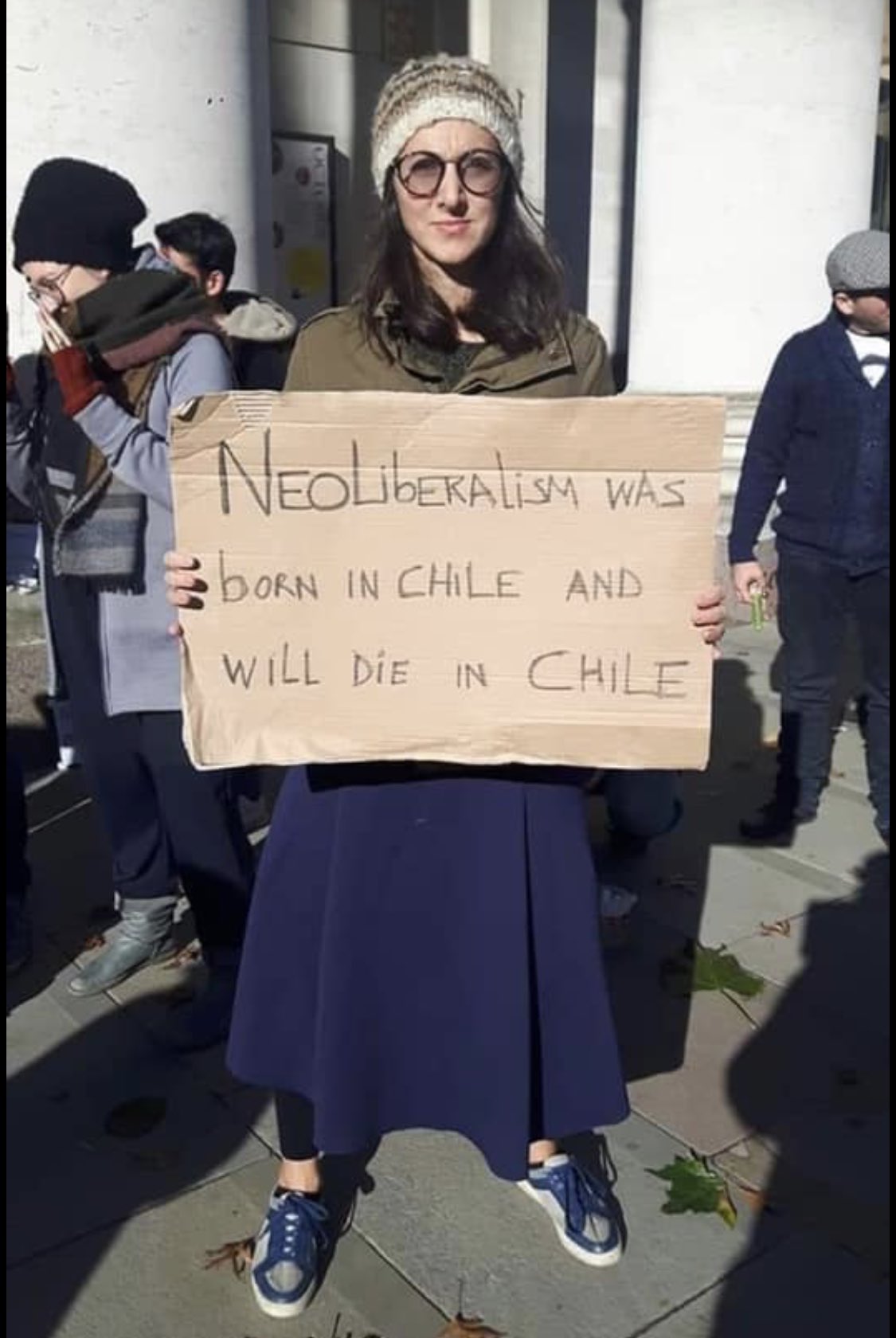What started with some students protesting by avoiding paying an increase in subway fares has turned into one of the largest mobilizations seen in Chile since it returned to democracy in 1990. Despite the state of emergency and curfew, hundreds of thousands of people are resisting the violent repression of the military and police and taking to the streets to protest. What are they demanding? A life worth living.
To get more context on ongoing events in Chile, we’re sharing this interview with Pierina Ferretti (Fundación Nodo XXI) by Caroline Kim (Rosa Luxemburg Foundation).
What makes thousands of people take to the streets? What made it explode like this?
What is happening in Chile is clearly an expression of social discontent that has been accumulating for a long time in very broad social layers. That is why this enormous protest has spread massively throughout the whole country. Even in cities and towns where there had never been protests, people are taking to the streets now. This reflects the very high level of widespread social discontent, weariness, and exhaustion that had accumulated.
This might seem strange in a country like Chile, which had built an image of itself, internally and externally, as a stable country, with a functioning economy, a country that has systematically reduced poverty, with a high level of access to consumer goods. However what helps explain this explosion are the very high levels of the precarization of labor and life and the insecurity felt by large sectors of the population in the country. For example, the fear of getting sick and not being able to pay for medical treatment, the fear of growing old because pension payments are miserable, the extreme labor precarity and flexibility, the difficulty of getting a stable job, the elevated cost of living and the lack of social rights.
One example: public education is very expensive, university tuition in the Chilean state university can easily cost nearly $550 a month. The average salary in Chile is around $710 a month, half the country earns less than the average, around $410. The average pension is $290 a month. With these salaries and these pensions it is impossible to live. These living conditions are exhausting, and that is what is exploding now.

What or who is the outburst directed against?
There is a growing delegitimization of the institutions of the state, of political parties, of Congress, of business people, of the Catholic Church, and now, with these protests, even of television. There is a sensation that all of these institutions are captured by an elite that only governs and legislates for their own benefit, harming the majority of the population. Many cases of corruption have come out, in the army, the police, within the state, there have been cases in which the government has forgiven millions of dollars in debts and taxes to large corporations, at the same time as it chases small debtors and common people. There is a growing consciousness that those sectors of the elite are constantly abusing and looting the population.
This outburst is so massive and it represents so many different sectors that it is impossible to classify it in the logic of left and right, it is a mobilization that explodes all those types of categories for understanding social conflict. One sign that I saw said: “We are neither from the right nor the left, we are from below and we are coming for those on top.” We can see that with this mobilization a “we” (those of us who are abused) and a them (those who abuse us) is being constructed.
Why are the protests taking place now?
Although an explosion of this magnitude is always surprising, it is not completely unexpected, what the press says about it being “a crisis that nobody saw coming” is not true. Many of us were aware that this country was a pressure cooker and that at some point it was going to blow up. The increase in the subway fare was the drop that overflowed the glass in the sea of discontent, anguish, and exhaustion that many people in Chile feel. It was an accumulation of discontent.
It is also taking place in a context of a right-wing government that won the elections with a discourse of economic recovery, job creation, improving living conditions and access to consumer goods. The slogan of Piñera’s government was “Better times are coming.” And that promise has not been fulfilled, on the contrary, growth has clearly stagnated. Furthermore, the president represents that business class and symbolizes the elite that profits off the rest of the population. It is a very well-known fact that Piñera embezzled a bank in the 1980s. However, the explosion is not specifically against Piñera, it is against a model that has been administered and intensified during almost thirty years of democracy both by the Concertación (center left) and by the right. Here nobody is safe from being challenged.
That is where the slogan “It’s not 30 pesos, it’s 30 years” comes from. It refers to the trigger of the protests, the increase in subway fares to 30 pesos, but also to the more structural causes, 30 years of accumulated discontent, as you say…
Of the many slogans, that is one of the most powerful. The slogans on the street synthesize what is happening very well. Neoliberalism in Chile does not originate in the neoliberal cycle of the 1990s, the most intense period of neoliberalization in the rest of Latin America, but rather in the cycle that starts with the dictatorship. This model has been implemented since the late 1970s. After forty years, the social effects start being felt and radicalized. That is the material basis of the outburst that we are leading. It is the discontent of neoliberal Chile.
Chile is a country that was considered a “neoliberal paradise,” with a working class that is willing to put up with very difficult conditions of labor flexibility, lack of rights, and exploitation. In Chile there are no universal social rights guaranteed by the state, such as health care, education, pensions, housing – those services are provided by private companies, which, in turn, receive enormous amounts of resources from the state. It is a myth that neoliberalism shrinks the state. Public spending has increased steadily but those resources largely to toward paying private companies that profit off of providing social services.
Who are the people going out into the streets?
It is a truly massive and popular movement that represents the heterogeneity of the Chilean people. It is not homogeneous social groups, quite the opposite. It is the most precarious sectors, unskilled workers, with very low wages, but also young professionals with university degrees, who are probably the first in their family to attend university, but that is not guaranteeing that they can make a living, have a salary that is enough to live off of, and they have to drive Uber once they clock out from their jobs. There are professionals from a precarious middle class that still has high levels of consumption but who live permanently exhausted and therefore constantly resort to taking out debt. Seventy percent of the population is indebted. This mobilization is made up of an expansive and heterogeneous world that is intersected by the condition of precarity and insecurity.
People are also holding cacerolazos in upper and upper middle class neighborhoods. It is impressive to see them in the streets with their pots and pans. The image that probably comes to mind of upper class people having cacerolazos is when they held them against Salvador Allende more than forty years ago. However, the people who live in those neighborhoods today are not the owners of Chile, nor are they in the top 1%. Those people no longer live there, they went farther away. The people holding cacerolazos in those upper middle class neighborhoods shout slogans that have to do with being able to lead a life with dignity and against abuses. They too feel these abuses, they too have problems making it to the end of the month.

Who is organizing the protests?
Although this is so massive, it continues to be a spontaneous mobilization of the population. It is important to emphasize that, because it speaks a lot about the subjects who are in the streets. Of course, all of us activists and the existing political organizations in Chile are there: unions, political parties, social organizations, and, as the days go by, the organizations are taking the initiative in terms of calling for marches, assemblies, etc. It is also true that all of us who were in the big student struggles of 2006 and 2011 and further back are there. Everything that has been accumulated from those struggles is in the streets today. But we, organized society, did not start it nor do we lead it, it is impossible to lead. It is a society that spontaneously convened itself. Here nobody can direct it or say when this ends, or under what conditions we will go back home.
In the first days, you would go to the plazas and not see any banners from political parties or organizations. There were no speakers, no stage, a purely spontaneous self-convening. People went by themselves or with a friend or with their family. This says a lot about the characteristics of Chilean society today. This mobilization is not only made up of those of us who are activists and are always at all the protests. It exceeds all the limits and therefore it does not respond to the logic of organizations nor their discourse or leadership. This is the most massive response to a call that we have had in the country’s recent history, convened by nobody and by everyone at the same time. It is very impressive. The people who are there are people who have never in their lives been involved in organizing. Alongside all of those people, are the activists. And that is impressive, it is impressive that it has occurred in such a spontaneous way that overflows any type of organization.
Can you describe what is happening in the streets these days?
In Santiago, since the beginning of the protests, a pattern has developed of going to one of the main plazas in the city, Plaza Italia. People gather in the plaza throughout the day until the curfew starts. It is a mixture of a party, protest, and repression. People with pots, people dancing, people doing choreography, people screaming, people applauding, people in the surrounding area drinking beer, smoking a joint. In general they are very young kids and there is an air of celebration and joy, a popular party. In the evenings people arrive who you can tell are coming from work to pass by the plaza.
The landscape is very dynamic and has changed over time. In the first days, people would go to the plaza without many materials, maximum some pots and signs, and generally people came by themselves or in very small groups. As the days went by, many more signs appeared, more dances, people playing live music, stand-up shows on the street, the fan clubs of the biggest soccer teams starting showing up, people selling beer, food, banners. Additionally, people start to arrive better prepared to mitigate the effects of teargas, with masks and other materials. The atmosphere is one of a party, a lot of joy. There is a lot of humor and irony in the signs, enormous creativity. There is also rage, when a police or military helicopter flies over the plaza, everything is interrupted and you can hear a loud “Out with the military” chanted by everyone. But what predominates is the joy and the street party. In parallel to all of this, the police are repressing and attempting to disperse. When the repression intensifies, people retreat and later return and the party continues. It stays, it does not move.

What happens in the neighborhoods at night is that people go bang pots and pans outside of their houses and at the meeting points. There is a generalized refusal of the curfew. It is the first time that we have had a curfew since the dictatorship, the older generations who lived through the dictatorship, were afraid and thought that people would stay in. But on the contrary, when the hour of the curfew approached, people stayed in the streets in mass, banging their pots.
But we have also seen scenes of terror. Having the military in the street is not a game, but a danger to life itself. There has been torture, assassinations, sexual violence against women who have been detained. There is also a class character to the repression. It is especially crude in the popular neighborhoods. But people keep going out and disobeying the curfew, especially younger people. It is a generation that is not afraid, that defies authoritarianism, that will not go home despite the brutality and images of horror that are circulating. People have not gone home and they keep protesting, they stay in the streets.
Chile is one of the countries with one of the most powerful feminist movements in recent years. Do you think that this has influenced the current explosion? What is the feminist analysis of the protests?
On the one hand, there is the awareness that feminism has created in society, which has to do with questioning the forms and conditions of life that, until recently, were naturalized and lived through in silence. What we see very clearly is the exhaustion, the weariness, the fatigue that were suffered in private, behind the closed doors of the household, in solitude, with only support of family and personal networks. This explosion has taken that suffering that was experienced inside the home out onto the streets, into the plazas.
People often blame themselves for not being capable enough, as if their problems were caused by individual inadequacies or personal inabilities, and that produces a lot of personal and social suffering. That anguish goes out into public space. People are becoming conscious of the fact that these are structural conditions, caused socially by the system that is producing this. It is a central element that is in line with the feminist analysis that has been created about violence and debt: escaping private confinement and making it collective, opening it collectively and therefore collectively seeking solutions to situations that produce insecurity. This explosion goes in that same direction from the private to the public.
Here there are people who ask what is feminist about this mobilization, because the main slogans are not those that are “typical” of feminism, about abortion, for example. We respond that everything is about feminism, in the sense that what feminism privileges is the reproduction of life, and what this movement aims to do is to take the reproduction of life out of the circuit of capital, so that they no longer profit from and do business with our lives. For many years, feminism has been putting the spotlight on the role of social reproduction as a key element for sustaining capitalism. This movement is a struggle to take back our lives from the market and to recover sovereignty over our lives, our bodies, our time, our territories. The feminist dimension of everything is rooted there.
This article originally appeared in Spanish at Lobo Suelto. Translated by Liz Mason-Deese.
